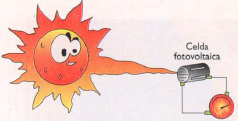Ejemplos claros son las pilas y las baterias electricas. Su funcionamiento se basa en la reacción química entre dos elementos diferentes. Si se intoducen dos placas metálicas, una cobre y otra de Zinc en un solución ácida más agua, se puede comprobar la existencia de un voltaje entre las dos placas.
By chemical reactions
Clear examples are the batteries and electric batteries. Its operation is based on the chemical reaction between two different elements. If two metal plates, one copper and zinc another in a more acidic solution water objects are introduced, you can verify the existence of a voltage between the two plates.
Por presión o vibración
Ciertos cristales tienen propiedades piezoeléctricas, es decir, convierten la energía mecánica en energía electrica al ser sometidos a presión o vibraciones; estos son el cuarzo la turmalina, el titanio de bario, la sal de rochelle, entre otros. Los cristales piezoelectricos tienen aplicaciones en la industria como el registro de niveles de ruido y la detección cambios de presión.
Pressure or vibration
Certain crystals have piezoelectric properties , ie convert mechanical energy into electrical energy when subjected to pressure or vibration ; these are quartz tourmaline, barium titanium , rochelle salt , among others. Piezoelectric crystals have applications in industry and recording noise levels and pressure changes detection.
Por calor y por luz
El componente que produce energía electrica a partir de la energía calórica se llama termopar y está formado por dos metales diferentes, por ejemplo, níquel y latón; en el la energía del calor lleva los electrones libres de un metal otro, produciendo entre los dos una fuerza electromotriz (FEM). Los termopares tienen varias aplicaciones en el hogar y en la industria, se usan en termómetros, controles de temperatura en hornos y alarmas contra incendios, etc.
También se puede obtener energía electrica por medio de la luz, ello se consigue con las celdas fotovoltaicas.
Heat and light
The component that produces electric energy from heat energy is called thermocouple and is formed of two different metals, eg nickel and brass; in heat energy it takes the free electrons of a metal other, producing between the two electromotive force (EMF). Thermocouples have several applications in the home and in industry, they are used in thermometers, temperature control in furnaces and fire alarms, etc.
You can also obtain electrical energy through light, this is achieved with photovoltaic cells.
POR MAGNETISMO
Todos conocemos los imanes, y los han manejado alguna que otra vez. Por lo tanto, podrá haber observado que, en algunos casos, los imanes se atraen y en otro caso se repelen. La razón es que los imanes tienen campos de fuerza que actúan uno sobre el otro recíprocamente.
La fuerza de un campo magnético también se puede usar para desplazar electrones. Este fenómeno recibe el nombre de magneto electricidad; a base de este un generador produce electricidad. Cuando un buen conductor, por ejemplo, el cobre se hace pasar a través de un campo magnético, la fuerza del campo suministrara la energía necesaria para que los átomos de cobre liberen sus electrones de valencia. Todos los electrones se moverán en cierta dirección, dependiendo de la forma en que el conductor cruce el campo magnético, el mismo efecto, se obtendrá si se hace pasar el campo a lo largo del conductor. El único requisito es que haya un movimiento relativo entre cualquier conductor y un campo magnético.
BY MAGNETISM
We all know magnets, and have handled occasionally. Therefore, there may be observed that, in some cases, the magnets attract and repel otherwise. The reason is that the magnets have force fields that act reciprocally one over the other.
The strength of a magnetic field can also be used to move electrons. This phenomenon is called magnetoelectricidad; based on this generator produces electricity. When a good driver, for example, copper is passed through a magnetic field, the field strength supply the energy needed for copper atoms release their valence electrons. All electrons will move in a certain direction, depending on how the driver crosses the magnetic field, the same effect will be obtained if the field is passed along the conductor. The only requirement is that there is a relative movement between any conductor and a magnetic field.





No hay comentarios.:
Publicar un comentario